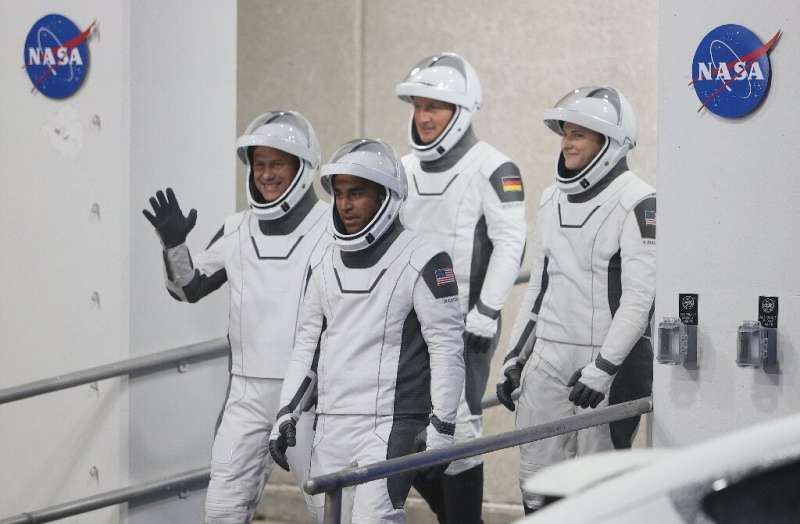
Copernical Team
Astronaut crew returns to Earth after six months on ISS
 NASA's Crew-3 mission returned home to Earth on Friday after six months aboard the International Space Station.
The SpaceX Dragon Endurance spacecraft with NASA astronauts Kayla Barron, Raja Chari and Tom Marshburn, as well as European Space Agency astronaut Matthias Maurer, undocked from the orbital laboratory a day earlier.
Their 23.5 hour journey back saw them splash down off the coas
NASA's Crew-3 mission returned home to Earth on Friday after six months aboard the International Space Station.
The SpaceX Dragon Endurance spacecraft with NASA astronauts Kayla Barron, Raja Chari and Tom Marshburn, as well as European Space Agency astronaut Matthias Maurer, undocked from the orbital laboratory a day earlier.
Their 23.5 hour journey back saw them splash down off the coas Welcome home Matthias - Crew-3 splashes down

ESA astronaut Matthias Maurer is safely back on Earth after splashing down off the coast of Florida, USA, at 05:43 BST/06:43 CEST today alongside NASA astronauts Raja Chari, Thomas Marshburn and Kayla Barron in Crew Dragon capsule Endurance.
China launches Jilin-1 commercial satellites
 China on Thursday launched a Long March-2D rocket to place a group of eight satellites in space.
Satellite Jilin-1 Kuanfu 01C, together with seven Jilin-1 Gaofen 03D satellites, was lifted at 10:38 a.m. (Beijing Time) from the Taiyuan Satellite Launch Center in the northern province of Shanxi and soon entered the preset orbit.
With its wide coverage, Jilin-1 Kuanfu 01C can provide im
China on Thursday launched a Long March-2D rocket to place a group of eight satellites in space.
Satellite Jilin-1 Kuanfu 01C, together with seven Jilin-1 Gaofen 03D satellites, was lifted at 10:38 a.m. (Beijing Time) from the Taiyuan Satellite Launch Center in the northern province of Shanxi and soon entered the preset orbit.
With its wide coverage, Jilin-1 Kuanfu 01C can provide im Hubble reveals surviving companion star in aftermath of supernova
 NASA's Hubble Space Telescope has uncovered a witness at the scene of a star's explosive death: a companion star previously hidden in the glare of its partner's supernova. The discovery is a first for a particular type of supernova - one in which the star was stripped of its entire outer gas envelope before exploding.
The finding provides crucial insight into the binary nature of massive s
NASA's Hubble Space Telescope has uncovered a witness at the scene of a star's explosive death: a companion star previously hidden in the glare of its partner's supernova. The discovery is a first for a particular type of supernova - one in which the star was stripped of its entire outer gas envelope before exploding.
The finding provides crucial insight into the binary nature of massive s NASA's Swift tracks potential magnetic flip of monster black hole
 A rare and enigmatic outburst from a galaxy 236 million light-years away may have been sparked by a magnetic reversal, a spontaneous flip of the magnetic field surrounding its central black hole.
In a comprehensive new study, an international science team links the eruption's unusual characteristics to changes in the black hole's environment that likely would be triggered by such a magneti
A rare and enigmatic outburst from a galaxy 236 million light-years away may have been sparked by a magnetic reversal, a spontaneous flip of the magnetic field surrounding its central black hole.
In a comprehensive new study, an international science team links the eruption's unusual characteristics to changes in the black hole's environment that likely would be triggered by such a magneti NASA's Psyche starts processing at Kennedy
 Bound for an asteroid of the same name, the orbiter is undergoing final preparations for its August launch.
Since its arrival on April 29, the Psyche spacecraft has moved into the Payload Hazardous Servicing Facility at NASA's Kennedy Space Center in Florida, where technicians removed it from its protective shipping container, rotated it to vertical, and have begun the final steps to prepa
Bound for an asteroid of the same name, the orbiter is undergoing final preparations for its August launch.
Since its arrival on April 29, the Psyche spacecraft has moved into the Payload Hazardous Servicing Facility at NASA's Kennedy Space Center in Florida, where technicians removed it from its protective shipping container, rotated it to vertical, and have begun the final steps to prepa Solving the mystery of frost hiding on Mars
 A new study using data from NASA's Mars Odyssey orbiter may explain why Martian frost can be invisible to the naked eye and why dust avalanches appear on some slopes.
Scientists were baffled last year when studying images of the Martian surface taken at dawn by NASA's Mars Odyssey orbiter. When they looked at the surface using visible light - the kind that the human eye perceives - they co
A new study using data from NASA's Mars Odyssey orbiter may explain why Martian frost can be invisible to the naked eye and why dust avalanches appear on some slopes.
Scientists were baffled last year when studying images of the Martian surface taken at dawn by NASA's Mars Odyssey orbiter. When they looked at the surface using visible light - the kind that the human eye perceives - they co Examining the Heart of Webb: The Final Phase of Commissioning
 NASA's James Webb Space Telescope is now experiencing all seasons - from hot to cold - as it undergoes the thermal stability test. Meanwhile, activities are underway for the final phase of commissioning: digging into the details of the science instruments, the heart of Webb. To complete commissioning, we will measure the detailed performance of the science instruments before we start routine sci
NASA's James Webb Space Telescope is now experiencing all seasons - from hot to cold - as it undergoes the thermal stability test. Meanwhile, activities are underway for the final phase of commissioning: digging into the details of the science instruments, the heart of Webb. To complete commissioning, we will measure the detailed performance of the science instruments before we start routine sci NASA identifies Artemis 1 rocket issues, plans another wet dress rehearsal for June
 NASA is targeting early June for its next attempt of the Artemis 1 wet dress rehearsal, officials announced on Thursday.
The test aims to demonstrate that the rocket can be safely loaded with propellant and practice the launch day procedures, aside from actually launching, to identify concerns and potential issues.
Previous attempts at the wet dress, conducted in April, resulted
NASA is targeting early June for its next attempt of the Artemis 1 wet dress rehearsal, officials announced on Thursday.
The test aims to demonstrate that the rocket can be safely loaded with propellant and practice the launch day procedures, aside from actually launching, to identify concerns and potential issues.
Previous attempts at the wet dress, conducted in April, resulted Astronaut crew returning to Earth after six months on ISS

NASA's Crew-3 mission was returning home to Earth on Thursday after six months aboard the International Space Station.
The SpaceX Dragon Endurance spacecraft with NASA astronauts Kayla Barron, Raja Chari, and Tom Marshburn, as well as European Space Agency astronaut Matthias Maurer undocked from the orbital laboratory overnight.
Their 23.5 hour journey back should see them splash down off the coast of Florida at 12:43 am on Friday (0443 GMT).
They leave behind the one Italian and three American astronauts of Crew-4, and three Russian cosmonauts.
